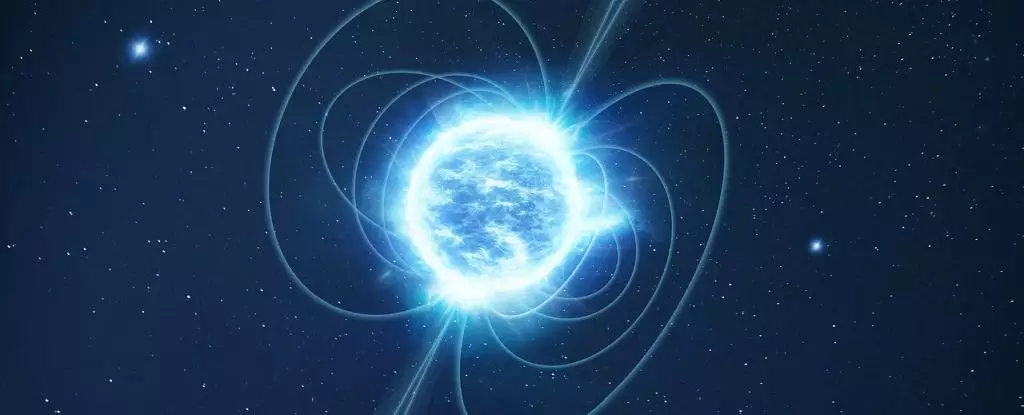In the boundless darkness beyond the edges of our Milky Way galaxy, astronomers have stumbled upon a celestial enigma that challenges long-held beliefs about the lifecycle of neutron stars. SGR 0501+4516, a magnetar — a rare form of neutron star known for its extraordinarily strong magnetic fields — has become the focal point of intense scrutiny and speculation. With findings from the Hubble and Gaia telescopes, scientists are reevaluating the assumptions surrounding the origins of these cosmic phenomena. The latest research suggests that our understanding of magnetar formation may be fundamentally flawed, indicating that we may need to rethink what we know about the birth of these mysterious stellar giants.
Understanding Magnetars
Magnetars are not mere curiosities; they are some of the densest objects we know of, second only to black holes. Born from the remains of massive stars that have undergone a catastrophic core-collapse supernova, magnetars differ from typical neutron stars in one significant way: their magnetic fields are off the charts. The magnetic field of a magnetar is approximately a thousand times stronger than that of a typical neutron star and a quadrillion times that of Earth’s magnetic field. The question that has perplexed astronomers for decades is: how do these extreme entities come into existence?
Historically, it was believed that magnetars emerged through the same processes as ordinary neutron stars, primarily resulting from the violent death throes of massive stars. The expectation was straightforward: observe a magnetar and find the remnants of a supernova nearby. In the case of SGR 0501+4516, the proximity to the supernova remnant HB9 once suggested a correlation. However, recent insights challenge this narrative, shaking the foundations of our understanding.
Astounding Observations that Shift Paradigms
The combined analytical power of Hubble and Gaia revealed that SGR 0501+4516 could not be associated with the HB9 remnant as previously thought. Researchers, led by astronomer Ashley Chrimes from the European Space Agency, employed Hubble images contextualized with data from the Gaia mission to meticulously trace the motion of the magnetar in the sky. The results were illuminating: the observed velocity of SGR 0501+4516 was inconsistent with its alignment to HB9. The absence of any nearby supernova remnants further complicates and upends the established narrative surrounding this magnetar’s origins.
What might this mean? One explanation is that SGR 0501+4516 is much older than current estimates suggest, having possibly existed long enough for any associated remnants to dissipate over time. However, this idea contradicts the current understanding that magnetars exist in an ephemeral state, only lingering for a few tens of thousands of years before evolving into a more sedate form.
Revisiting the Birth of SGR 0501+4516
An alternative theory posits that SGR 0501+4516 may not have been born from a traditional core-collapse supernova at all. Instead, it raises the possibility of a more intricate formation mechanism involving mergers. One intriguing scenario involves the collision of two low-mass neutron stars, or even the interaction of a neutron star with a white dwarf. This last possibility is particularly fascinating. Typically, white dwarfs remain stable until they gather too much mass from a nearby companion star, igniting catastrophic nuclear reactions that lead to their explosion. However, under particular conditions, these white dwarfs might collapse directly into neutron stars, giving rise to a magnetar like SGR 0501+4516.
Astronomer Andrew Levan’s observations emphasize the pressing need to rethink the parameters around magnetars’ existence. If this scenario is proven true, SGR 0501+4516 might represent a new class of formation pathways for magnetars, one that diverges significantly from traditional models and emphasizes the complexity of stellar evolution.
A New Dawn for Magnetar Research
The discovery surrounding SGR 0501+4516 underscores a groundbreaking crossroads in astronomy. With less than 30 magnetars identified in our galaxy, each one offers a unique insight into the vast cosmological processes that govern the lifecycle of stars. As researchers continue to explore the implications of these groundbreaking findings, it becomes increasingly clear that the universe is far more complex than we previously imagined. The secrets that SGR 0501+4516 holds may redefine our understanding not only of neutron stars, but of the fundamental processes that shape the cosmos.
In this era of advanced observation technology, the potential for revolutionary discoveries in stellar astrophysics is boundless. Whether SGR 0501+4516 prompts a paradigm shift in our understanding of magnetar formation or simply serves as a tantalizing mystery to solve, one thing remains certain: the night sky continues to inspire awe and wonder, beckoning us to explore further and deeper into its myriad mysteries.

